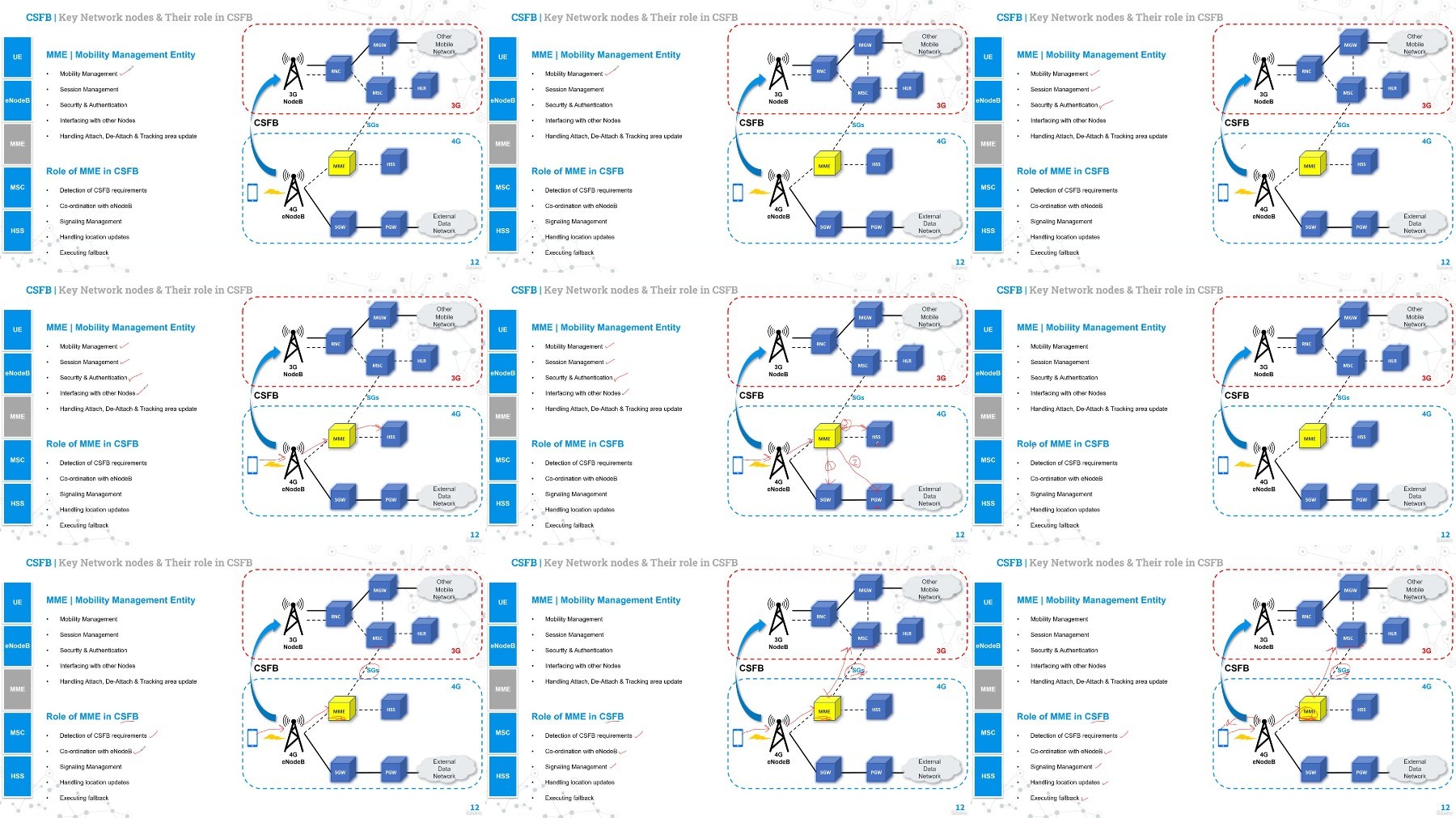Csfb In 4G NetWorks: Comprehensive Circuit Switch Fallback

Csfb In 4G Networks: Comprehensive Circuit Switch Fallback
Published 9/2024
MP4 | Video: h264, 1920x1080 | Audio: AAC, 44.1 KHz
Language: English | Size: 1.10 GB | Duration: 4h 6m
Learn everything about 4G CSFB, including architecture, signaling flows, real-world implementations in mobile networks
What you'll learn
CSFB and VoLTE concepts and differences
CSFB architecture and components overview
Call setup and handover processes in CSFB
CSFB signaling and protocols explained
Troubleshooting CSFB signaling issues
CSFB to VoLTE transition and real-world cases
Requirements
Basic understanding of mobile networks
Familiarity with LTE and 3G/2G technologies
No prior experience with CSFB required
Willingness to learn network signaling concepts
Description
Are you looking to master the essential concepts of Circuit Switch Fallback (CSFB) in 4G networks? This course provides an in-depth exploration of CSFB, the technology that allows LTE devices to switch to legacy 2G/3G networks for voice calls. As the only course of its kind, it offers a comprehensive, step-by-step guide to understanding CSFB architecture, signaling flows, and real-world applications.In this course, you will dive deep into the workings of CSFB, including call setup, handover processes, and location updates. We'll cover key network elements such as MME, MSC, eNodeB, and HSS, explaining their roles in the fallback process. Learn how operators like AT&T, Vodafone, and China Mobile implemented CSFB, along with real-world troubleshooting strategies for issues like call setup delays, paging failures, and inconsistent QoS.By the end of this course, you will have the knowledge and skills to optimize CSFB processes, troubleshoot common issues, and enhance network performance for voice services on 4G LTE networks. With hands-on Wireshark analysis of signaling messages and real-world case studies, this course ensures you are ready to handle the complexities of CSFB in today's mobile networks.What You Will Learn:Complete understanding of 4G CSFB architecture and call flows.How to capture and analyze CSFB signaling messages with Wireshark.Common issues in CSFB signaling and practical troubleshooting techniques.Real-world CSFB implementations and performance optimization from top operators.Deep insights into the roles of MME, MSC, HSS, eNodeB, and more in the fallback process.Who Should Enroll:Telecommunications engineers and network professionals.Students and professionals preparing for a career in mobile networks.Anyone looking to deepen their understanding of CSFB in 4G networks.Course Content:Section 1: LTE Voice OptionsOverview of LTE Voice Options: CSFB vs. VoLTECircuit Switched Fallback (CSFB): What It Is and How It WorksAdvantages and Disadvantages of CSFBVoice over LTE (VoLTE): Technology, Functionality, and BenefitsComparison of CSFB vs. VoLTE: Call Setup Time, Voice Quality, Data ServicesSection 2: CSFB ArchitectureHigh-Level Explanation of CSFB ArchitectureHow CSFB Works (High-Level Overview)Section 3: Key Network Nodes & Their Roles in CSFBUE (User Equipment): Capabilities and ISR SupporteNodeB: Role and Function in CSFB ProceduresMME: Role in Managing Fallback and SignalingMSC: Handling Voice Calls and SMS in CSFBHSS: Managing Subscriber Data and Location UpdatesSection 4: SGsAP Interface and ProtocolWhat is the SGs Interface and Its FunctionsSGsAP Protocol Stack (L1, L2, IP, SCTP, SGsAP) LayersExample of the Protocol Stack in Action: Call Flow and SignalingSection 5: SGsAP Signaling Messages (With Wireshark Analysis)SGsAP Location Update Request (Wireshark Included)SGsAP Location Update Accept (Wireshark Included)SGsAP Paging Request (Wireshark Included)SGsAP Paging Response (Wireshark Included)SGsAP Service Request (Wireshark Included)Section 6: CSFB Attach and Call ProceduresCSFB Attach Procedures ExplainedCSFB Mobile-Originated (MO) Call FlowCSFB Mobile-Terminated (MT) Call FlowDetach Procedures in CSFBTA/LA Update Procedures: Signaling and TriggersSection 7: Troubleshooting Common CSFB Signaling IssuesCall Setup Delay: Causes and TroubleshootingCall Drops During Fallback: Causes and SolutionsFailed Location Updates: Causes and SolutionsPaging Failures: Causes and TroubleshootingInconsistent QoS Parameters: Troubleshooting for Better Call QualitySection 8: Real-World CSFB Implementations and Performance MetricsAT&T's CSFB Implementation: Challenges and SolutionsVodafone's CSFB Implementation: Optimizing High-Mobility EnvironmentsChina Mobile's CSFB Implementation: Handling Large-Scale User BasesPerformance Metrics: Call Setup Time, Success Rates, and User FeedbackThis course is your one-stop solution for mastering CSFB, from the fundamentals to advanced implementation strategies. Join today and take your knowledge of mobile network voice services to the next level!
Overview
Section 1: Introduction to LTE Voice Solutions: CSFB and VoLTE
Lecture 1 Introduction to LTE Voice Solutions: CSFB and VoLTE
Lecture 2 Understanding Circuit Switched Fallback (CSFB)
Lecture 3 Pros and Cons of Circuit Switched Fallback (CSFB)
Lecture 4 Understanding Voice over LTE (VoLTE)
Lecture 5 Pros and Cons of Voice Over LTE (VoLTE)
Section 2: CSFB Architecture and Call Flow Overview
Lecture 6 High-Level Overview of CSFB Architecture
Lecture 7 High-Level CSFB Call Flow and Process
Section 3: Core Network Components and Their Roles in CSFB
Lecture 8 Key Network Nodes in CSFB: User Equipment (UE)
Lecture 9 Explaining the Role of eNodeB in CSFB
Lecture 10 The Role of MME in CSFB
Lecture 11 The Role of MSC in the CSFB
Lecture 12 The Role of HSS in the CSFB
Section 4: SGs Interface and Protocol Stack in CSFB
Lecture 13 Understanding the SGs Interface in LTE and CS Networks
Lecture 14 The SGsAP Protocol Stack: Layers and Functions
Lecture 15 SGsAP Protocol Stack in Action: Voice Call Example
Section 5: SGsAP Signaling Messages and Wireshark Analysis
Lecture 16 Introduction to SGsAP Signaling Messages
Lecture 17 SGsAP Location Update Request with Wireshark Analysis
Lecture 18 SGsAP Location Update Accept with Wireshark Analysis
Lecture 19 SGsAP Paging Request with Wireshark Analysis
Lecture 20 SGsAP Paging Response with wireshark analysis
Lecture 21 SGsAP Service Request with Wireshark Analysis
Section 6: CSFB UE States
Lecture 22 SGsAP UE States in CSFB
Section 7: CSFB Procedures: Attach, Call Flow, and Updates
Lecture 23 CSFB Attach procedures
Lecture 24 CSFB Mobile-Originated (MO) Call Flow
Lecture 25 CSFB Mobile-Terminated (MT) Call Flow
Lecture 26 CSFB Detach Procedures
Lecture 27 TA/LA Update Procedures in CSFB
Section 8: Troubleshooting Common CSFB Signaling Issues
Lecture 28 Common Issues in CSFB Signaling: Call Setup Delay
Lecture 29 Common Issues in CSFB Signaling: Call Drops During Fallback
Lecture 30 Common Issues in CSFB Signaling: Failed Location Updates
Lecture 31 Common Issues in CSFB Signaling: Paging Failures
Lecture 32 Common Issues in CSFB Signaling: Inconsistent QoS Parameters
Section 9: Real World Examples & Case studies
Lecture 33 AT&T, Vodafone & China Mobile
Telecom engineers wanting to learn CSFB,Students in telecommunications studies,Mobile network operators and technicians,Engineers preparing for VoLTE implementation

What you'll learn
CSFB and VoLTE concepts and differences
CSFB architecture and components overview
Call setup and handover processes in CSFB
CSFB signaling and protocols explained
Troubleshooting CSFB signaling issues
CSFB to VoLTE transition and real-world cases
Requirements
Basic understanding of mobile networks
Familiarity with LTE and 3G/2G technologies
No prior experience with CSFB required
Willingness to learn network signaling concepts
Description
Are you looking to master the essential concepts of Circuit Switch Fallback (CSFB) in 4G networks? This course provides an in-depth exploration of CSFB, the technology that allows LTE devices to switch to legacy 2G/3G networks for voice calls. As the only course of its kind, it offers a comprehensive, step-by-step guide to understanding CSFB architecture, signaling flows, and real-world applications.In this course, you will dive deep into the workings of CSFB, including call setup, handover processes, and location updates. We'll cover key network elements such as MME, MSC, eNodeB, and HSS, explaining their roles in the fallback process. Learn how operators like AT&T, Vodafone, and China Mobile implemented CSFB, along with real-world troubleshooting strategies for issues like call setup delays, paging failures, and inconsistent QoS.By the end of this course, you will have the knowledge and skills to optimize CSFB processes, troubleshoot common issues, and enhance network performance for voice services on 4G LTE networks. With hands-on Wireshark analysis of signaling messages and real-world case studies, this course ensures you are ready to handle the complexities of CSFB in today's mobile networks.What You Will Learn:Complete understanding of 4G CSFB architecture and call flows.How to capture and analyze CSFB signaling messages with Wireshark.Common issues in CSFB signaling and practical troubleshooting techniques.Real-world CSFB implementations and performance optimization from top operators.Deep insights into the roles of MME, MSC, HSS, eNodeB, and more in the fallback process.Who Should Enroll:Telecommunications engineers and network professionals.Students and professionals preparing for a career in mobile networks.Anyone looking to deepen their understanding of CSFB in 4G networks.Course Content:Section 1: LTE Voice OptionsOverview of LTE Voice Options: CSFB vs. VoLTECircuit Switched Fallback (CSFB): What It Is and How It WorksAdvantages and Disadvantages of CSFBVoice over LTE (VoLTE): Technology, Functionality, and BenefitsComparison of CSFB vs. VoLTE: Call Setup Time, Voice Quality, Data ServicesSection 2: CSFB ArchitectureHigh-Level Explanation of CSFB ArchitectureHow CSFB Works (High-Level Overview)Section 3: Key Network Nodes & Their Roles in CSFBUE (User Equipment): Capabilities and ISR SupporteNodeB: Role and Function in CSFB ProceduresMME: Role in Managing Fallback and SignalingMSC: Handling Voice Calls and SMS in CSFBHSS: Managing Subscriber Data and Location UpdatesSection 4: SGsAP Interface and ProtocolWhat is the SGs Interface and Its FunctionsSGsAP Protocol Stack (L1, L2, IP, SCTP, SGsAP) LayersExample of the Protocol Stack in Action: Call Flow and SignalingSection 5: SGsAP Signaling Messages (With Wireshark Analysis)SGsAP Location Update Request (Wireshark Included)SGsAP Location Update Accept (Wireshark Included)SGsAP Paging Request (Wireshark Included)SGsAP Paging Response (Wireshark Included)SGsAP Service Request (Wireshark Included)Section 6: CSFB Attach and Call ProceduresCSFB Attach Procedures ExplainedCSFB Mobile-Originated (MO) Call FlowCSFB Mobile-Terminated (MT) Call FlowDetach Procedures in CSFBTA/LA Update Procedures: Signaling and TriggersSection 7: Troubleshooting Common CSFB Signaling IssuesCall Setup Delay: Causes and TroubleshootingCall Drops During Fallback: Causes and SolutionsFailed Location Updates: Causes and SolutionsPaging Failures: Causes and TroubleshootingInconsistent QoS Parameters: Troubleshooting for Better Call QualitySection 8: Real-World CSFB Implementations and Performance MetricsAT&T's CSFB Implementation: Challenges and SolutionsVodafone's CSFB Implementation: Optimizing High-Mobility EnvironmentsChina Mobile's CSFB Implementation: Handling Large-Scale User BasesPerformance Metrics: Call Setup Time, Success Rates, and User FeedbackThis course is your one-stop solution for mastering CSFB, from the fundamentals to advanced implementation strategies. Join today and take your knowledge of mobile network voice services to the next level!
Overview
Section 1: Introduction to LTE Voice Solutions: CSFB and VoLTE
Lecture 1 Introduction to LTE Voice Solutions: CSFB and VoLTE
Lecture 2 Understanding Circuit Switched Fallback (CSFB)
Lecture 3 Pros and Cons of Circuit Switched Fallback (CSFB)
Lecture 4 Understanding Voice over LTE (VoLTE)
Lecture 5 Pros and Cons of Voice Over LTE (VoLTE)
Section 2: CSFB Architecture and Call Flow Overview
Lecture 6 High-Level Overview of CSFB Architecture
Lecture 7 High-Level CSFB Call Flow and Process
Section 3: Core Network Components and Their Roles in CSFB
Lecture 8 Key Network Nodes in CSFB: User Equipment (UE)
Lecture 9 Explaining the Role of eNodeB in CSFB
Lecture 10 The Role of MME in CSFB
Lecture 11 The Role of MSC in the CSFB
Lecture 12 The Role of HSS in the CSFB
Section 4: SGs Interface and Protocol Stack in CSFB
Lecture 13 Understanding the SGs Interface in LTE and CS Networks
Lecture 14 The SGsAP Protocol Stack: Layers and Functions
Lecture 15 SGsAP Protocol Stack in Action: Voice Call Example
Section 5: SGsAP Signaling Messages and Wireshark Analysis
Lecture 16 Introduction to SGsAP Signaling Messages
Lecture 17 SGsAP Location Update Request with Wireshark Analysis
Lecture 18 SGsAP Location Update Accept with Wireshark Analysis
Lecture 19 SGsAP Paging Request with Wireshark Analysis
Lecture 20 SGsAP Paging Response with wireshark analysis
Lecture 21 SGsAP Service Request with Wireshark Analysis
Section 6: CSFB UE States
Lecture 22 SGsAP UE States in CSFB
Section 7: CSFB Procedures: Attach, Call Flow, and Updates
Lecture 23 CSFB Attach procedures
Lecture 24 CSFB Mobile-Originated (MO) Call Flow
Lecture 25 CSFB Mobile-Terminated (MT) Call Flow
Lecture 26 CSFB Detach Procedures
Lecture 27 TA/LA Update Procedures in CSFB
Section 8: Troubleshooting Common CSFB Signaling Issues
Lecture 28 Common Issues in CSFB Signaling: Call Setup Delay
Lecture 29 Common Issues in CSFB Signaling: Call Drops During Fallback
Lecture 30 Common Issues in CSFB Signaling: Failed Location Updates
Lecture 31 Common Issues in CSFB Signaling: Paging Failures
Lecture 32 Common Issues in CSFB Signaling: Inconsistent QoS Parameters
Section 9: Real World Examples & Case studies
Lecture 33 AT&T, Vodafone & China Mobile
Telecom engineers wanting to learn CSFB,Students in telecommunications studies,Mobile network operators and technicians,Engineers preparing for VoLTE implementation

